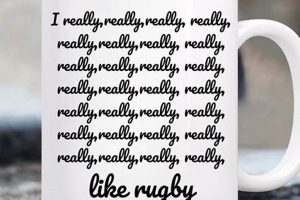What’s the difference between union and league rugby? Union and league rugby are two popular forms of rugby football that share a common history but have evolved into distinct sports with different rules and gameplay.
Editor’s Notes: Understanding the difference between union and league rugby is important for players, fans, and anyone interested in the sport. This guide will provide a comprehensive overview of the key differences between the two codes of rugby, helping you to make informed decisions about which one to play or watch.
After some analysis and digging, we’ve put together this guide to help you understand the difference between union and league rugby. We’ll cover the key differences in rules, gameplay, and strategy, so you can make an informed decision about which code is right for you.
Key differences
| Union | League |
|---|---|
| 15 players per team | 13 players per team |
| Played on a rectangular field | Played on an oval field |
| The ball can be kicked or carried forward | The ball can only be kicked forward |
| Tackles are made below the shoulders | Tackles can be made above or below the shoulders |
| Scrums are used to restart play after an infringement | Scrums are not used in league rugby |
Main article topics
- History of union and league rugby
- The key differences between union and league rugby
- The benefits of playing union and league rugby
- How to choose the right code of rugby for you
1. Number of players
The number of players on the field is one of the most obvious differences between union and league rugby. Union rugby is played with 15 players per team, while league rugby is played with 13. This difference has a significant impact on the way the game is played.
- Attacking: With more players on the field, union teams have a greater attacking threat. They can spread the ball wide and attack from multiple angles. League teams, on the other hand, have to be more direct in their attack, as they have fewer players to work with.
- Defending: With fewer players on the field, league teams have to be more organized in defense. They have to work together to close down space and tackle effectively. Union teams, on the other hand, can afford to be a bit more aggressive in defense, as they have more players to cover the field.
- Set pieces: The number of players on the field also affects the way set pieces are played. In union rugby, scrums and lineouts are contested by 8 players from each team. In league rugby, scrums are contested by 6 players from each team, and lineouts are not used.
The difference in the number of players on the field is just one of the many factors that contribute to the different styles of play between union and league rugby. However, it is a key difference that has a significant impact on the way the game is played.
2. Field shape
The shape of the field is another key difference between union and league rugby. Union rugby is played on a rectangular field, while league rugby is played on an oval field. This difference has a significant impact on the way the game is played.
- Attacking: The rectangular shape of the union rugby field gives teams more space to spread the ball wide and attack from multiple angles. League rugby teams, on the other hand, have to be more direct in their attack, as the oval shape of the field limits their options.
- Defending: The oval shape of the league rugby field makes it easier for teams to defend their line. This is because the shorter sides of the field mean that there is less space for attackers to exploit.
- Kicking: The shape of the field also affects the way kicking is used in the game. In union rugby, teams can kick the ball long and high to gain territory. In league rugby, teams are more likely to kick the ball short and along the ground, as this is more effective on an oval field.
The shape of the field is just one of the many factors that contribute to the different styles of play between union and league rugby. However, it is a key difference that has a significant impact on the way the game is played.
3. Ball handling
This difference in ball handling rules has a significant impact on the way the game is played. In union rugby, teams can use a variety of attacking options, including running with the ball, kicking the ball, or passing the ball. This makes the game more open and free-flowing. In league rugby, teams are more limited in their attacking options, as they can only kick the ball forward. This makes the game more structured and.
- Attacking: The ability to carry the ball forward gives union teams a greater attacking threat. They can use their forwards to batter through the opposition defense, or they can use their backs to run around the opposition defense. League teams, on the other hand, have to be more direct in their attack, as they can only kick the ball forward. This makes it easier for the opposition defense to set up and defend.
The difference in ball handling rules is just one of the many factors that contribute to the different styles of play between union and league rugby. However, it is a key difference that has a significant impact on the way the game is played.
4. Scrums
Scrums are a key part of union rugby, but they are not used in league rugby. This is one of the most significant differences between the two codes of rugby.
Scrums are used to restart play after an infringement has been committed. They are also used to restart play after the ball has gone out of bounds. Scrums are formed by the two packs of forwards from each team. The forwards bind together in three rows, with the front row players hooking their arms around each other’s necks. The scrum is then pushed forward by the two teams. The team that wins the scrum gains possession of the ball.
Scrums can be a very dangerous part of the game. Players can be injured in scrums if they are not properly prepared. Scrums also slow down the game, which can be frustrating for fans. However, scrums are an essential part of un
ion rugby, and they add to the excitement of the game.
The absence of scrums in league rugby makes the game faster and more open. League rugby teams are also able to score more points because they do not have to waste time setting up scrums. However, the absence of scrums also makes league rugby a more dangerous game. Players are more likely to be injured in league rugby because they are not protected by the scrum.
The difference between union rugby and league rugby is a matter of opinion. Some people prefer the more physical nature of union rugby, while others prefer the faster and more open style of league rugby. Ultimately, the best code of rugby is the one that you enjoy the most.
| Union rugby | League rugby |
|---|---|
| Scrums are used to restart play after an infringement. | Scrums are not used. |
| The game is slower and more structured. | The game is faster and more open. |
| Teams are able to score more points. | Teams are less likely to be injured. |
5. Lineouts
The absence of lineouts in league rugby is one of the key differences between the two codes of rugby. Lineouts are used to restart play after the ball has gone out of bounds. They are also used to give teams a chance to gain possession of the ball after a kick. The absence of lineouts in league rugby makes the game faster and more open. It also means that teams are less likely to be able to gain territory through kicking.
Lineouts can be a very effective way to gain possession of the ball. However, they can also be a dangerous part of the game. Players can be injured in lineouts if they are not properly prepared. Lineouts also slow down the game, which can be frustrating for fans.
The absence of lineouts in league rugby has a number of implications. First, it makes the game faster and more open. Second, it means that teams are less likely to be able to gain territory through kicking. Third, it makes the game more dangerous for players.
Overall, the absence of lineouts in league rugby is a significant difference between the two codes of rugby. It has a number of implications for the way the game is played.
| Union rugby | League rugby |
|---|---|
| Lineouts are used to restart play after the ball goes out of bounds. | Lineouts are not used. |
| The game is slower and more structured. | The game is faster and more open. |
| Teams are less likely to be able to gain territory through kicking. | Teams are more likely to be able to score points. |
| Lineouts can be a dangerous part of the game. | The game is less dangerous for players. |
6. Conversions
The presence or absence of conversions is one of the key differences between union and league rugby. Conversions are a way for teams to score additional points after scoring a try. In union rugby, the team that scores a try has the option of kicking a conversion for two points. The conversion is taken from directly in front of the goalposts, and the kicker must kick the ball between the goalposts and over the crossbar.
- Facet 1: Impact on scoring
The presence of conversions in union rugby gives teams an additional way to score points. This can make a significant difference in close games, as a team that scores a try and converts it will have a two-point advantage over a team that only scores a try.
- Facet 2: Strategic implications
The presence of conversions also has strategic implications. In union rugby, teams often have to decide whether to kick for a conversion or to try to score another try. This decision can be a difficult one, as kicking for a conversion is a relatively easy way to score points, but scoring another try gives the team a chance to score more points.
- Facet 3: Excitement and drama
Conversions can also add to the excitement and drama of a rugby match. A successful conversion can give a team a significant lead, while a missed conversion can give the opposition team a chance to get back into the game. Conversions can also be very difficult to kick, especially in windy or wet conditions.
Overall, the presence or absence of conversions is one of the key differences between union and league rugby. Conversions have a significant impact on the scoring, strategy, and excitement of the game.
7. Drop goals
The presence or absence of drop goals is another key difference between union and league rugby. Drop goals are a way for teams to score points without having to score a try. In union rugby, a player can score a drop goal by dropping the ball and kicking it over the crossbar. The drop goal is worth three points.
- Facet 1: Strategic implications
The presence of drop goals in union rugby gives teams an additional tactical option. Teams can use drop goals to score points from long range, or to punish the opposition for offside or other infringements. Drop goals can also be used to close out a game, as they are relatively easy to kick and can give a team a three-point lead.
- Facet 2: Excitement and drama
Drop goals can also add to the excitement and drama of a rugby match. A well-taken drop goal can give a team a significant lead, while a missed drop goal can give the opposition team a chance to get back into the game. Drop goals can also be very difficult to kick, especially in windy or wet conditions, which makes them even more exciting to watch.
- Facet 3: Impact on the game
The presence of drop goals in union rugby can have a significant impact on the way the game is played. Teams often have to decide whether to kick for a drop goal or to try to score a try. This decision can be a difficult one, as kicking for a drop goal is a relatively easy way to score points, but scoring a try gives the team a chance to score more points.
Overall, the presence or absence of drop goals is one of the key differences between union and league rugby. Drop goals have a significant impact on the strategy, excitement, and drama of the game.
FAQs on the Difference Between Union and League Rugby
Here are some frequently asked questions about the difference between union and league rugby:
Question 1: What is the main difference between union and league rugby?
The main difference between union and league rugby is the way the ball is handled. In union rugby, the ball can be kicked or carried forward. In league rugby, the ball can only be kicked forward.
Question 2: How many players are on a union rugby team?
There are 15 players on a union rugby team.
Question 3: How many players are on a league rugby team?
There are 13 players on a league rugby team.
Question 4: What is a scrum?
A scrum is a set piece that is used to restart play after an
infringement. Scrums are only used in union rugby.
Question 5: What is a lineout?
A lineout is a set piece that is used to restart play after the ball goes out of bounds. Lineouts are only used in union rugby.
Question 6: What is a conversion?
A conversion is a kick that is taken after a try is scored. Conversions are worth two points in union rugby.
Question 7: What is a drop goal?
A drop goal is a kick that is taken from a dropped ball. Drop goals are worth three points in union rugby.
These are just a few of the key differences between union and league rugby. For more information, please consult the resources listed below.
Summary of key takeaways:
- Union and league rugby are two different codes of rugby football with different rules and gameplay.
- The main difference between union and league rugby is the way the ball is handled.
- Union rugby is played with 15 players per team, while league rugby is played with 13 players per team.
- Scrums and lineouts are set pieces that are only used in union rugby.
- Conversions and drop goals are kicks that are used to score points in union rugby.
Transition to the next article section:
Now that you know the difference between union and league rugby, you can decide which code of rugby is right for you. If you are interested in a more physical and structured game, then union rugby is a good choice. If you are interested in a faster and more open game, then league rugby is a good choice.
Tips on Understanding the Difference Between Union and League Rugby
Understanding the difference between union and league rugby can be a challenge, but it is important for players, fans, and anyone interested in the sport. Here are a few tips to help you understand the key differences between the two codes of rugby:
Tip 1: Focus on the ball handling rules. The most fundamental difference between union and league rugby is the way the ball is handled. In union rugby, the ball can be kicked or carried forward. In league rugby, the ball can only be kicked forward.
Tip 2: Pay attention to the number of players on the field. Union rugby is played with 15 players per team, while league rugby is played with 13 players per team. This difference in the number of players has a significant impact on the way the game is played.
Tip 3: Learn about the different set pieces. Scrums and lineouts are set pieces that are used to restart play after an infringement or when the ball goes out of bounds. Scrums are only used in union rugby, while lineouts are used in both union and league rugby.
Tip 4: Understand the scoring system. Tries, conversions, and drop goals are all ways to score points in rugby. Tries are worth 5 points in both union and league rugby. Conversions are worth 2 points in union rugby and 1 point in league rugby. Drop goals are worth 3 points in union rugby and 1 point in league rugby.
Tip 5: Watch games of both codes of rugby. One of the best ways to understand the difference between union and league rugby is to watch games of both codes. This will help you to see the different rules and gameplay in action.
Summary of key takeaways:
- The most fundamental difference between union and league rugby is the way the ball is handled.
- Union rugby is played with 15 players per team, while league rugby is played with 13 players per team.
- Scrums are set pieces that are only used in union rugby.
- The scoring system is different in union and league rugby.
- Watching games of both codes of rugby is a great way to understand the difference between them.
Transition to the article’s conclusion:
By following these tips, you will be well on your way to understanding the difference between union and league rugby. So get out there and enjoy the game!
Conclusion
Union and league rugby are two distinct codes of rugby football with different rules and gameplay. The most fundamental difference between the two codes is the way the ball is handled. In union rugby, the ball can be kicked or carried forward. In league rugby, the ball can only be kicked forward. This difference in ball handling rules has a significant impact on the way the game is played.
Other key differences between union and league rugby include the number of players on the field, the use of scrums and lineouts, and the scoring system. Union rugby is played with 15 players per team, while league rugby is played with 13 players per team. Scrums are set pieces that are only used in union rugby. The scoring system is also different in the two codes of rugby. Tries are worth 5 points in both union and league rugby. Conversions are worth 2 points in union rugby and 1 point in league rugby. Drop goals are worth 3 points in union rugby and 1 point in league rugby.
Understanding the difference between union and league rugby is important for players, fans, and anyone interested in the sport. By following the tips outlined in this article, you will be well on your way to understanding the key differences between the two codes of rugby. So get out there and enjoy the game!







